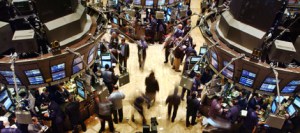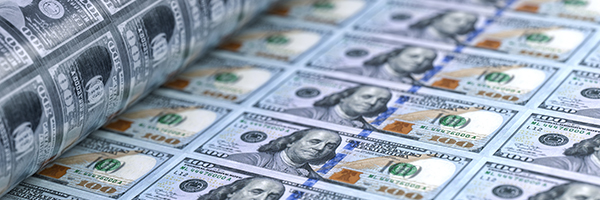 August 22, 2025
August 22, 2025
What You Need to Know Today:
Wait, you mean there might not be a September interest rate cut?
Ahead of Federal Reserve chair Jerome Powell’s Friday speech at the central bankers’ conclave in Jackson Hole, four (and counting) Fed governors spoke up to cast doubt on the inevitability of a 25 basis point interest rate cut at the Fed’s September 17 meeting. Odds of a cut at the meeting plunged on the CME FedWatch tool today, Thursday, August 21, falling to 75% from 82.4% yesterday and 92.1% a week ago.

Wait, you mean there might not be a September interest rate cut?
Ahead of Federal Reserve chair Jerome Powell’s Friday speech at the central bankers’ conclave in Jackson Hole, four (and counting) Fed governors spoke up to cast doubt on the inevitability of a 25 basis point interest rate cut at the Fed’s September 17 meeting. Odds of a cut at the meeting plunged on the CME FedWatch tool today, Thursday, August 21, falling to 75% from 82.4% yesterday and 92.1% a week ago.

Now the stock market is getting nervous–but it comes too late for my August VIX options
In the last few sessions, as the market worries about what Federal Reserve chair Jerome Powell will say about inflation and interest rates and the likelihood of an interest rate cut at the Fed’s September 17 meeting, volatility as measured by the CBOE S&P 500 Volatility Index (VIX) has started to climb. The VIX rose another 6.37% to 16.69 today, Thursday, August 21. That’s a big move from the low of 14.78 on August 19. But the increase is nowhere near enough to save the VIX Call options I bought back on May 18. Those options had strike prices of 22 and 26–and consequently they expired worthless on the expiration date of August 20.
Back on July 19 I worried that this market was determined not to price in risk and I warned that anyone who owned these options had only about a two week window for the markets to begin more realistically to price in risk. If that move didn’t start by August 3 or so, it would be time to sell and take losses in this volatility play.
When I wrote that on July 19, the VIX was at 16.45. From there the VIX moved consistently lower–well except for a very brief spike to 20.37 on August–hitting 14.36 on August 13.

Good news, bad news in manufacturing index today
Good news. U.S. manufacturing is expanding at the fastest rate in more than three years on stronger demand. The S&P Global flash August factory purchasing managers index rose 3.5 points to 53.3, the highest since May 2022, according to data released Thursday. Figures above 50 show the sector is expanding.

Fed minutes today don’t bring market joy
Stocks dropped for a fourth day in a row on Wednesday, August 20. So far I think all we’re seeing is typical seasonal weakness with profit taking in the market’s most expensive technology stocks–plus nervousness ahead of Friday’s Jackson Hole speech by Federal Reserve chair Jerome Powell. Will he say anything to disrupt the financial market’s belief in a September 17 interest rate cut or to lower expectations for subsequent cuts in the rest of 2025? Today’s release of minutes from the Fed’s July 30 meeting didn’t help the market’s nerves.

More pressure from Trump on the Fed
Does anybody think this ISN’T about putting more pressure on the Federal Reserve to cut interest rates immediately and repeatedly? Federal Housing Finance Agency Director Bill Pulte has urged Attorney General Pam Bondi to investigate Federal Reserve Governor Lisa Cook over a pair of mortgages. This is the latest in a series of moves by the Trump administration to increase legal scrutiny of Democratic figures and appointees. Cook was nominated to the Fed by former President Joe Biden. The FHFA head posted on social media that his accusations give Trump “cause to fire” her. And then today President Donald Trump called on Federal Reserve Governor Lisa Cook to resign. Trump said Wednesday that Cook “must resign now,” citing Pulte’s allegations.

Special Report: What to do with the Magnificent 7 stocks Now? Part 1
Going forward, I’m not all that interested in investing in the “old” Magnificent Seven. But I am interested in investing in a new “enhanced” Magnificent Seven that builds on and increases the exposure of these stocks to the market’s AI enthusiasm.
Live Market Report (20 minute delay)

Wait, you mean there might not be a September interest rate cut?
Ahead of Federal Reserve chair Jerome Powell’s Friday speech at the central bankers’ conclave in Jackson Hole, four (and counting) Fed governors spoke up to cast doubt on the inevitability of a 25 basis point interest rate cut at the Fed’s September 17 meeting. Odds of a cut at the meeting plunged on the CME FedWatch tool today, Thursday, August 21, falling to 75% from 82.4% yesterday and 92.1% a week ago.

Now the stock market is getting nervous–but it comes too late for my August VIX options
In the last few sessions, as the market worries about what Federal Reserve chair Jerome Powell will say about inflation and interest rates and the likelihood of an interest rate cut at the Fed’s September 17 meeting, volatility as measured by the CBOE S&P 500 Volatility Index (VIX) has started to climb. The VIX rose another 6.37% to 16.69 today, Thursday, August 21. That’s a big move from the low of 14.78 on August 19. But the increase is nowhere near enough to save the VIX Call options I bought back on May 18. Those options had strike prices of 22 and 26–and consequently they expired worthless on the expiration date of August 20.
Back on July 19 I worried that this market was determined not to price in risk and I warned that anyone who owned these options had only about a two week window for the markets to begin more realistically to price in risk. If that move didn’t start by August 3 or so, it would be time to sell and take losses in this volatility play.
When I wrote that on July 19, the VIX was at 16.45. From there the VIX moved consistently lower–well except for a very brief spike to 20.37 on August–hitting 14.36 on August 13.

Good news, bad news in manufacturing index today
Good news. U.S. manufacturing is expanding at the fastest rate in more than three years on stronger demand. The S&P Global flash August factory purchasing managers index rose 3.5 points to 53.3, the highest since May 2022, according to data released Thursday. Figures above 50 show the sector is expanding.

Fed minutes today don’t bring market joy
Stocks dropped for a fourth day in a row on Wednesday, August 20. So far I think all we’re seeing is typical seasonal weakness with profit taking in the market’s most expensive technology stocks–plus nervousness ahead of Friday’s Jackson Hole speech by Federal Reserve chair Jerome Powell. Will he say anything to disrupt the financial market’s belief in a September 17 interest rate cut or to lower expectations for subsequent cuts in the rest of 2025? Today’s release of minutes from the Fed’s July 30 meeting didn’t help the market’s nerves.

More pressure from Trump on the Fed
Does anybody think this ISN’T about putting more pressure on the Federal Reserve to cut interest rates immediately and repeatedly? Federal Housing Finance Agency Director Bill Pulte has urged Attorney General Pam Bondi to investigate Federal Reserve Governor Lisa Cook over a pair of mortgages. This is the latest in a series of moves by the Trump administration to increase legal scrutiny of Democratic figures and appointees. Cook was nominated to the Fed by former President Joe Biden. The FHFA head posted on social media that his accusations give Trump “cause to fire” her. And then today President Donald Trump called on Federal Reserve Governor Lisa Cook to resign. Trump said Wednesday that Cook “must resign now,” citing Pulte’s allegations.
While you worry about a slowing U.S. economy, don’t forget the worsening slump in China
China’s economy clocked its deepest slowdown of the year in July. Causes?

The true tariff chaos is in the details: goods from tableware to strollers take a hit
President Donald Trump stunned the logistics industry and a wide swath of the consumer good sector on Friday by widening his steel and aluminum tariffs to include more than 400 consumer items that contain the metals. “Contain” is the key word. Suddenly without notice of clarification makers of goods from motorcycles to tableware face new tariffs. Will the new rates be tacked onto existing tariffs? How much “content” will trigger the tariff? Good questions. And nobody knows. Customs brokers and importers in the United States were given little notice of the change, which went into effect Monday and did not exclude goods in transit.

The U.S. labor force is shrinking and that’s not good for economic growth
At just over a 4% rate, unemployment remains low, and it has edged only a bit higher since the start of the year.
So the economy is doing fine, right?
Well, no. Because the labor force is shrinking. If the labor force had increased this year at the pace it did last year, the unemployment rate would be headed toward 5%,

Everybody nervously waits for Powell’s speech at Jackson Hole on Friday
Trading volumes dried up as traders waited for Federal Reserve chair Jerome Powell’s speech at the Jackson Hole central bankers’ get together. (Talk about a wild party! Can you imagine what goes on after all the hot talk about the velocity of money?)

Trump’s tariffs hit small business especially hard–and these companies account for half of all job creation
Small U.S. companies, the source of more than half of the country’s job creation in recent years, are struggling to comply with President Donald Trump’s new tariffs and cope with growing financial strains clobbering them from higher import costs.

AI startup Perplexity to make a bid to buy Chrome from Google: What’s that about?
Perplexity will, reportedly, make a bid to buy Alphabet’s (GOOG) dominant Chrome search engine for $34.5 billion. So what’s that all about?

Saturday Night Quarterback says, For the week ahead expect…
.With Nvidia (NVDA) not scheduled to report earnings until August 27 next week,the stock market will just have to make do with Federal Reserve chair Jerome Powell’s Friday, August 22 speech at the Fed’s global central bankers annual confab in Jackson Hole for a catalyst.

Betting on a 50 point cut in September: Wishful thinking or smart speculation?
The argument is about 25 versus 50.
The financial markets are pricing in a near 100% chance of 25 basis point interest rate cut from the Federal Reserve at its September 17 meeting. On August 14, the CME FedWatch tool calculates that the futures market is pricing in 90.6% odds of a 25 basis point cut to bring its benchmark short-term invest rate down to a rate of 4.00% to 4.25% from the current range of 4.25% to 4.50%. The contest is now about whether the Fed will cut by 50 basis points to a range of 3.75% to 4.00%

Slumping cardboard box sales signal slowing economy
In case you need another sign that the economy is slowing: sales of the corrugated cardboard used to make the boxes that transport everything from doughnuts to dishwashers are slumping.

Where’s the inflation from tariffs? It may have shown up today in wholesale prices
U.S inflation at the wholesale level accelerated in July by the most in three years, suggesting companies are passing along higher import costs related to tariffs. The producer price index (PPI) increased 0.9% from a month earlier, the largest advance since consumer inflation peaked in June 2022, according to a Bureau of Labor Statistics report out Thursday. The PPI rose at a 3.3% annual rate in July. That’s significantly higher than the 2.7% annual increase in the all-items CPI report released on tuesday. Or the 3.1% annual rate of increase in the core CPI. It’s not a lock but usually price increases at the wholesale level show up with a lag in consumer prices.

The important CPI inflation number–CORE–headed in the wrong direction in July
If you only read the headlines about headline CPI inflation, you might think that Yesrerday’s report on july inflation was good news. The headline number–that’s the”all-items” inflation number–for July showed that the annual pace of inflation remained at an annual rate of 2.7%. That’s the same as the annual rate reported in June and just under economists’ expectations.
But core inflation, which excludes volatile food and energy and is the inflation metric that the Federal Reserve watches when setting its benchmark interest rate, rose at an annual 3.1% rate from a year, hotter than the prior month’s increase and above expectations.

Inflation watch: Is coffee the next eggs?
Remember how in the last election, the price of eggs became the standing for official inflation numbers? everybody bought eggs. Everybody felt the pain from soaring egg prices. Everybody knew what a dozen eggs used to cost and what they cost now. Eggs focused the pain and the rage at inflation. Coffee looks poised to be the next eggs.

Student loan delinquencies rise
Americans with a collective $1.6 trillion in student loans are finally required to make payments again, following five years of Covid-era leniency measures. But only a third of those receiving bills are actually paying them with the rest either unable or unwilling to comply, according to estimates from the Department of Education as of April.

Trump extends China tariff truce
Today President Donald Trump signed an executive order extending the tariff truce between the United States and China for another three months. The current tariff truce was due to expire tomorrow, Tuesday, August 12.

Unemployment soars! For computer science college graduates?
Trying to figure out the impact of AI on the job market? Look no further than the market for recent college graduates in computer science.
Among college graduates ages 22 to 27, computer science and computer engineering majors are facing some of the highest unemployment rates, 6.1% and 7.5% respectively



